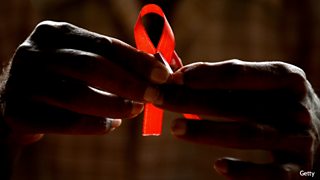HIV and AIDS: A global health success story?
Sophia Wilkinson
Senior Health Advisor, Βι¶ΉΤΌΕΔ Media Action
Tagged with:

On World AIDS Day, our senior health advisor explains how media and communication has helped tackle HIV and AIDS in Nigeria.
December 1st is World AIDS Day (WAD), a time when people across the globe wear their red ribbons to raise awareness about HIV and for people to show their solidarity with and support for people living with HIV. It’s also a chance to remember the 39 million people who have died across 40 years.
For me, WAD is an opportunity to reflect on the great strides that have been made in overcoming this condition and to take stock of what needs to happen next.
A success story?
HIV features less than it used to in the media, even though media and communication have been at the heart of the response. Perhaps this is because the fight against HIV is a huge global health success story. Here’s why:
- The Millennium Development Goal to reverse and halt the spread of HIV was achieved earlier this year, ahead of target.
- Cuba has managed to eliminate the transmission of HIV from mothers to their children entirely. Indeed, the overall progress to stop children acquiring HIV has been huge: in the past 15 years, infections in children have dropped by almost 60 percent.
- The number of people who now receive treatment that will help them to lead near-normal lives with HIV has shot up in recent years. UNAIDS puts the number at almost 16 million. In 2010, it was half that. This is significant because science has shown that people successfully on treatment are no longer infectious. Treatment prevents the transmission of HIV. It’s also significant because it confounds the doubters who said the health systems in low-income countries just wouldn’t be able to cope.
- The new Sustainable Development Goal for HIV is to get to zero new infections by 2030. That target would have been absolutely unthinkable a decade ago.
So is the job done? No. The negative comments in some media around the recent announcement from the Hollywood actor Charlie Sheen that he’s living with HIV provided a stark reminder that fear, stigma and ignorance about the condition still exists.
Two million new infections
And the number of people living with HIV and AIDS is still huge: there were two million new infections between 2013 and 2014. Well over half the number of people infected don’t know that they are living with HIV because they haven’t been tested. There are also still some 20 million people living with HIV who aren’t getting treatment, mainly living in the world’s poorest countries.
Βι¶ΉΤΌΕΔ Media Action has been at the forefront of using media to prevent the spread of HIV and AIDS in Nigeria – a country with one of the highest rates of people living with HIV in the world. On TV, clever and imaginative PSAs (public service announcements) in Hausa and Pidgin English helped address common misconceptions, including a view that HIV can be transmitted through witchcraft.
In addition to TV, youth radio programmes such as (a weekly radio show in Pidgin English) helped bring the topic of HIV and AIDS to people through a network of radio stations across Nigeria. Research found that 77% of Flava listeners (our weekly radio show in Pidgin English) reported having learned something from the show and 35% reported behaviour change: of those, 23% said they now use condoms, 17% reported having been tested for HIV and 14% said that they have stopped having multiple sexual partners.
So, on World AIDS Day, what’s the role of media and communication going forward? Approaches need to be carefully targeted to encourage people, often the most vulnerable and marginalised in societies, to come forward to be tested, to actively participate in prevention measures. Yet, broad-based, far reaching strategies are still required to address the complex stigma that feeds the disease. And there are always the new generations to protect. It’s a huge challenge, but with so much already gained there is more that can be done.
Related links
Follow us on and
